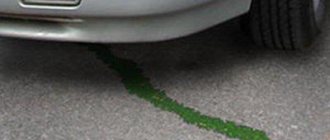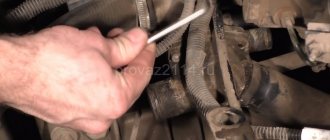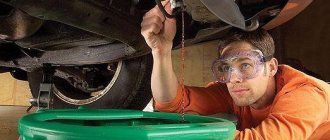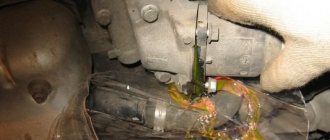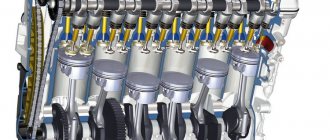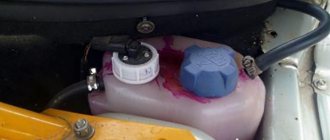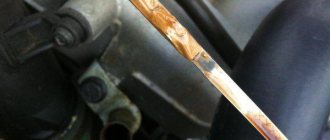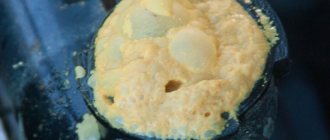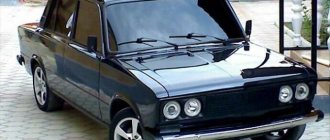If antifreeze or other antifreeze gets into the cylinder block, this is an unpleasant problem and can lead to serious engine damage. Therefore, every car enthusiast should be able to recognize it, as well as identify the causes and be ready to eliminate them.
We also recommend reading the article on how to flush a car's radiator without removing it. From this article you will learn about what and how to flush the engine cooling system.
How to find out that antifreeze has got into the cylinder block
To begin with, it is worth clarifying that in this case, antifreeze is not only a brand of coolant, but also a common name for any antifreeze. And it doesn’t matter at all what exactly ends up in the block. In other words, the signs that there is antifreeze or antifreeze in the cylinder block will be very similar:
- exhaust gases become white, thick, and steam-like. In winter, of course, this effect can also occur from frost. Therefore, it is worth paying attention to the smell: the smell of antifreeze is often clearly felt;
- the level of coolant in the reservoir will constantly decrease, although not by much. This, of course, does not always mean that the antifreeze goes into the cylinder block, but it’s still worth taking a closer look;
- the oil on the dipstick changes color: it either becomes too dark or almost white;
- one or more spark plugs may be wet and smell like antifreeze;
- an emulsion forms under the oil filler neck;
These are the main signs that indicate that the liquid in the car’s engine cooling system is entering the cylinders. Before you take any action, you need to find out exactly the cause of this problem.
How to determine antifreeze in oil
Many, especially novice, car enthusiasts are interested in the question of how to find out that antifreeze has entered the oil system of the car’s engine. In fact, there are a number of typical signs by the presence of which one can judge the occurrence of this malfunction. Among them:
- of oil and antifreeze appears, Accordingly, the more antifreeze or antifreeze that has leaked into the oil system, the more such a mixture will be in its composition. It is not difficult to check the presence of emulsion in the engine; to do this, you just need to look at the condition of the engine oil on the dipstick. There will be a similar emulsion on the oil filler neck, just open the cap.
- Drop in coolant level . This sign is indirect, since antifreeze can leave the system not into the oil, but simply into the engine compartment. Therefore, in this case, additional diagnostics are necessary.
- Engine overheating . This symptom is also indirect, since it can be caused by other problems. However, if antifreeze and oil are mixed, then, accordingly, the cooling and lubrication systems will stop working normally, which will also lead to rapid overheating of the engine, especially when it operates at significant loads (speeds).
- Presence of oil in antifreeze . As a rule, when one (or both) systems depressurizes, mutual mixing of these process fluids occurs. At the same time, the antifreeze turns black and begins to smell like burnt oil, and the cooling system does not work well. You can look at the condition of the antifreeze by opening the cap of the expansion tank of the cooling system.
- Decrease in engine power . This factor is a logical result of the deterioration of the cooling and lubrication systems. Often the motor “troits”. Additional diagnostics must be performed as other problems may be causing the loss of power.
- White smoke from the exhaust pipe . This is true for both gasoline and diesel engines, however, the reasons why this phenomenon is caused differ in the first and second cases. If white smoke comes out of the exhaust system, then there is antifreeze in the engine elements. For gasoline engines, the coolant enters the cylinders, and for diesel engines, it enters the manifold.
- The spark plugs will have a light tint (the color of burnt antifreeze). True, this is only an indirect sign; a number of other reasons will need to be considered.
- Air bubbles in the expansion tank of the cooling system. They can be seen through the transparent tank body or by opening the cap (at high engine speeds). The higher they are, the more air will escape from the system. This sign directly indicates depressurization of the system.
- Coolant leaks from under the cylinder head gasket onto the body of the unit itself. At the same time, regardless of their color, it is necessary to check the condition of the engine oil and antifreeze in the engine to ensure they are mixed with each other.
If a car owner encounters one or more of the symptoms listed above, then it makes sense to check the condition of the engine oil, coolant, and also perform additional diagnostics of individual engine parts, which will be discussed below.
This is interesting: Painting wheels with powder paint - protect your wheels from winter!
Why does antifreeze get into the cylinders?
- As you know, coolants circulate in the engine through special insulated channels.
Those, although isolated, have breaks at the junctions of different parts of the engine. More precisely, such breaks are concentrated at the junction of the cylinder head with the block itself. A gasket is installed here, which prevents coolant leakage, both inward and outward. When this gasket burns out, then the antifreeze gets into the cylinder or flows out. And in severe cases it goes both ways. By the way, some drivers who are especially concerned about their car keep the outside of the engine almost perfectly clean and paint it with a special heat-resistant silver paint, so that in the event of an external leak, it can be immediately noticed. But the gasket is only one of the reasons. - The second is flaws on the cylinder head itself. Or rather, on the plane with which it is pressed against the block. If there are defects, then the gasket will not fit tightly and gaps will remain. As a rule, such nuances are not noticeable at first glance. The simplest way to determine is to apply a metal ruler: it is placed edge-on on a plane and all irregularities become immediately visible.
- The third reason is perhaps the most unpleasant. These are cracks in the cylinder block body itself. More precisely, in the channels through which the refrigerant circulates.
If you can't find the leak
Not finding a leak doesn't mean you don't have one. Once the engine has cooled completely, check your vehicle's coolant level. Take note of how much fluid is in your car's coolant tank. The coolant level indicator is located on the side of the transparent plastic tank. Most tanks have clear minimum and maximum markings. The coolant level should be between o and “max”. After this, drive the car for several days and see if the fluid is leaking somewhere or not. If the liquid does not go anywhere, congratulations, everything is fine. Otherwise, sign up at the nearest service station.
Sources
- https://bumper.guru/klassicheskie-modeli-vaz/sistema-ohdazhdeniya/uhodit-antifriz-podtekov-net-chto-delat.html
- https://etlib.ru/blog/771-uhodit-antifriz-pochemu-gde-i-kak-ustranit-tech
- https://AutoVogdenie.ru/kak-najti-i-ustranit-tech-antifriza.html
- https://uremont.com/publications/articles/tech-antifreeza
- https://autozhidkosti.ru/antifreeze/kuda-uhodit-antifriz.html
- https://zen.yandex.ru/media/id/5beafefd84edee00aa843c51/3-prichiny-pochemu-iz-avtomobilia-uhodit-ohlajdaiuscaia-jidkost-techet-antifriz—5c3388f2b4150800aa727e94
- https://zapchasti.expert/zhidkosti/ohlazhdayushhie/ustranenie-prichin-utechki-antifriza.html
- https://zen.yandex.ru/media/dvigun/chto-delat-esli-vytek-antifriz-5cf5606734ace300afb2eb36
What to do if antifreeze gets into the cylinders
So, after determining why there was antifreeze in the engine cylinder, the question arises of how to eliminate this malfunction. The simplest solution, as you might have guessed, is to eliminate the first cause of such a leak.
We are talking about replacing the gasket, since it will be enough just to replace the gasket under the cylinder head to restore tightness. Its cost is relatively low, especially when it comes to domestic cars.
The most difficult action in this case will be removing, and borrowing and replacing the head itself. However, there is nothing overly complicated about this: you just need to have the appropriate keys and follow the sequence of unscrewing and tightening the nuts. Moreover, the cylinder head is tightened using a torque wrench in compliance with all standards for a specific car model.
By the way, if antifreeze gets into the cylinders, then you will have to remove the head in any case and do troubleshooting. In the event that there are flaws (on the plane where the gasket fits), you will have to do grinding.
In most cases, it is difficult to do without the help of a specialist. But this procedure will not help if the head has become deformed (as they say, it has “begun”) due to overheating or incorrectly tightened nuts. If so, then only replacing the head will save you from getting antifreeze into the cylinder. Well, if antifreeze gets inside because cracks have appeared in the block, then repair or replacement of the block itself will be required.
We also recommend reading the article about what to do if the cylinder block or cylinder head is cracked. From this article you will learn how to remove a crack using accessible methods.
What to do
The method for eliminating an antifreeze leak depends on the cause of its occurrence. The simplest situation is a burnout or rupture of the gasket. It cannot be repaired, so the gasket should be replaced.
If a deformation of the cylinder head occurs, most often you cannot do without the help of a specialist, since performing this action incorrectly will lead to failure of the part. A deformed cylinder head will require grinding on a special machine. But if the defects are serious, it is necessary to remove more than the permissible layer. In this case, the part will have to be replaced.
The discovery of a large crack in the cylinder block requires its immediate replacement. Small cracks in cast iron or silumin blocks can be repaired by welding - electric or “cold”.
Replacing the BC gasket with your own hands
Replacing the cylinder block gasket is a simple manipulation, and any car owner can easily cope with this task on his own. The main condition for obtaining the desired result without additional breakdowns is to follow the car manufacturer’s recommendations regarding the strength and procedure for tightening the cylinder head with a torque wrench. The sequence of actions when replacing the gasket is as follows.
- The car is de-energized by removing the negative terminals of the battery. If necessary, drain the antifreeze and reduce the pressure in the supply.
- First, the attachments are disconnected from the cylinder block. If you have no experience working with parts, it is advisable to sketch or otherwise record the sequence of dismantling the elements. Craftsmen advise arming yourself with a marker and applying the appropriate marks to each dismantled part.
- The screws securing the cylinder head begin to unscrew from the center, making half a turn each time.
- Disconnect the cylinder head and remove the old gasket.
- Clean the cylinder head and wash it with gasoline.
- Install a new gasket. To ensure precise installation, there are special bushings on the center of the block. The hole for the oil passage should be between the 3rd and 4th cylinders.
- Screw all parts in reverse order.
- Return hanging elements to their place
IMPORTANT! The fastening bolts must be cleaned before unscrewing. This will prevent the key from falling off and protect the bolt splines from damage.
Repairing a cylinder crack
The most common way to seal a BC crack is welding. The work requires certain skills and abilities, since a violation of the technology will lead to divergence of the seam, and the problem will return. The welding sequence and technology is as follows:
- The ends of the crack on the block are drilled at an angle of 90 degrees. This procedure is necessary to prevent further expansion of the crack.
- The cylinder block is heated to 650 degrees. Then a cast-iron-copper filler wire is applied to the crack and a continuous weld is made using flux.
- The part is gradually cooled in a heating cabinet. Sudden cooling of the cylinder block after welding is unacceptable: this will lead to rupture of the seam and complete failure of the part.
The seam on the part can be made without heating, using electric welding and copper electrodes in a tin wrapper. In this case, the resulting seam requires additional reinforcement with epoxy resin. The surface is degreased with acetone or a special compound, then a layer of epoxy paste is applied to the seam with a spatula. After this, the BC is dried for 24 hours at room temperature. After drying, the seam is sanded.
Minor cracks can be repaired without welding by applying fiberglass and epoxy resin. The surface of the crack is degreased, then several layers of fiberglass are applied one by one, each coated with epoxy paste.
Antifreeze getting into the cylinders: consequences
If coolant is detected in the cylinders, the engine cannot be operated further. Antifreeze itself, like any other antifreeze, although it is a rather aggressive and toxic substance, does not harm the engine. However, it contains ethylene glycol, which, when mixed with oil, forms insoluble solids. Based on their physical properties, they can well be considered abrasives. Naturally, such additives will not add service life to the engine.
In addition, as a result of the interaction of coolant components with engine oil, scale-like deposits (emulsion) are formed on the walls of oil channels and oil lines. As a result, the passage of the channels deteriorates, oil circulation is disrupted, and filters quickly become unusable. The lubricant itself is diluted by the coolant, as a result of which the lubricating and protective, as well as detergent and other important functions of the oil are lost.
We must not forget that when antifreeze enters the cylinders, engine cooling deteriorates greatly and it begins to overheat. Overheating can cause the engine head, as well as the cylinder block itself, to become deformed.
Negative consequences for the engine
The penetration of even a small amount of liquid from the cooling system is fraught with the following consequences for the power unit:
- Deterioration in lubricant performance
. Antifreeze consists of a special concentrate and distilled water, and therefore significantly reduces the lubricating properties of oil when mixed with it. - Accelerated wear of the internal combustion engine
. If the problem is not corrected in a timely manner, it may be necessary to overhaul the engine. - The appearance of a knock during operation
. It occurs almost immediately after liquid enters the internal structure. Most often, the knocking noise is caused by the crankshaft and camshaft liners. The load on the bearings (liners) increases sharply, which causes defects to appear on their surface, which leads to knocking. - Almost complete erasure of the working surface of the liners
. Parts change color, usually acquire a brown tint, scratches and other mechanical damage appear on them. Additives present in motor oil are converted into abrasive balls when mixed with antifreeze, which damage the functional layer of bearings. - Rapid overheating of the engine even under light load
. The oil turns out to be diluted and lubricates the elements of the power unit less well, as a result of which the friction force increases and heating increases sharply. The oil mixture acquires the consistency of an emulsion. - In oil with antifreeze, solid zinc and calcium compounds with phosphorus
, which can damage almost all internal elements of the cylinder block, including its walls. - Clogged channels
through which lubricant circulates through the engine. They become clogged with the emulsion formed during the process of mixing antifreeze with oil. The motor is not properly lubricated and cooled, which leads to a sharp decrease in its performance characteristics.
Causes
The main reason for the flow of antifreeze into the cylinder block is a violation of its tightness. Experts identify three malfunctions that lead to the formation of such a leak.
- Burnt, ruptured or loose cylinder head gasket. The main reason for gasket burnout is engine overheating. It can occur when there is a lack of coolant in the engine or when its quality is low.
- Deformation of the cylinder head, also leading to a loose fit of the gasket. Defects in the head can occur due to overheating or due to incorrectly tightened nuts. According to statistics, in 80% of cases it occurs due to the incorrect tightening order. The problem of cylinder head deformation from overheating is typical for aluminum heads - cast iron heads immediately form cracks.
- Cracks in the channels of the cylinder block cooling jacket. The appearance of cracks is caused by adding cold water to an overheated engine or due to defrosting of the cylinder head in severe frost.
IMPORTANT! The quality of the cylinder head gasket plays an important role in the formation of leaks. As a rule, cheap, non-original gaskets quickly fail, and they have to be replaced after several thousand kilometers.
Useful tips for car owners
Penetration of antifreeze into the power unit and mixing with oil can lead to catastrophic consequences
. The same consequences are relevant in cases where the car owner uses ordinary water rather than special antifreeze. If signs such as white exhaust, bubbles in the expansion tank, a drop in the fluid level, an increase in the oil level, or the formation of an emulsion on the parts of the lubrication system appear, operation of the engine should be stopped immediately.
The need for major repairs may occur even if a small amount of liquid
. After fixing the problem, it is important to completely change the oil. In this case, it is necessary to use a special flushing fluid before adding new oil. Flushing will remove all contaminants that have formed due to the ingress of antifreeze.
IMPORTANT!
If coolant gets into the lubrication system, it is recommended
to turn off the engine immediately .
For delivery to a service station, it is better to use third-party help, since even short-term engine operation can lead to damage to the cylinder block. It is much easier and cheaper to install a new cylinder head gasket than to then repair a damaged head, liners, crankshaft and camshaft. Most often, it is the deformation of the cylinder head gasket
. It can crack and burn. This element is non-repairable, so damage can only be eliminated by replacement. When performing repairs, the manufacturer's recommendations should be followed. It is advisable to use original spare parts. When installing a new head, it is important to follow the manufacturer's specifications regarding the strength and procedure for tightening the cylinder head.
Source
